| | |
| Type | Manufacturer |
|---|---|
| Founded | 1998 |
| Headquarters | Torrance, California |
| Products | Wind turbines |
PacWind, Inc. is a wind turbine manufacturing company based in Torrance, California, United States.
| | |
| Type | Manufacturer |
|---|---|
| Founded | 1998 |
| Headquarters | Torrance, California |
| Products | Wind turbines |
PacWind, Inc. is a wind turbine manufacturing company based in Torrance, California, United States.
The company was founded in 1998, and released their first patented vertical axis wind turbines in May 2006. [1] [2] In 2007, they added another two models of turbines to their product lineup. [3]
In November 2008, certain intellectual property assets of PacWind were acquired by WePOWER, LLC. Since then, the original PacWind website has gone offline, and none of the original turbine designs are available for sale. The WePOWER product lineup as of the end of 2009 were the Falcon series turbines ranging from 600W to 12 kW. [4]
On May 17, 2007, PacWind gained a large amount of publicity when TV personality Jay Leno announced that, as part of an ongoing project with Popular Mechanics , he would be having one of the 'Delta II' (10 kW) model turbines installed on the roof of his garage. [5] [6]
During the "I Spy Bill Nye" episode of Living With Ed , Ed Begley, Jr. has a 'SeaHawk' (500w) model turbine installed on the roof of his house. [7]
Sixteen of PacWind's turbines were used in the design of the first eco-friendly billboard in Times Square in 2008. [8]

Edward James Begley Jr. is an American actor and environmental activist. Begley has appeared in hundreds of films, television shows, and stage performances. He played Dr. Victor Ehrlich on the television series St. Elsewhere (1982–1988). The role earned him six consecutive Primetime Emmy Award nominations and a Golden Globe Award nomination. He also co-hosted, along with wife Rachelle Carson, the green living reality show titled Living with Ed (2007–2010).

Enercon GmbH is a wind turbine manufacturer based in Aurich, Lower Saxony, Germany. It has been the market leader in Germany since the mid-1990s. Enercon has production facilities in Germany, Brazil, India, Canada, Turkey and Portugal. In June 2010, Enercon announced that they would be setting up Irish headquarters in Tralee.

Savonius wind turbines are a type of vertical-axis wind turbine (VAWT), used for converting the force of the wind into torque on a rotating shaft. The turbine consists of a number of aerofoils, usually—but not always—vertically mounted on a rotating shaft or framework, either ground stationed or tethered in airborne systems.
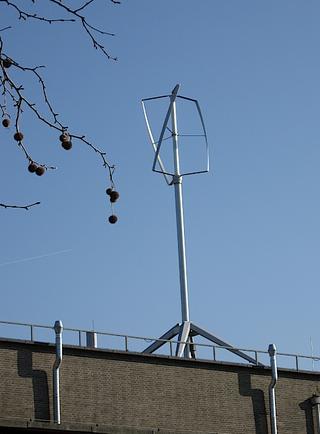
The Turby is a brand of vertical-axis Darrieus wind turbine. The three vertical aerofoil blades have a helical twist of 60 degrees, similar to Gorlov's water turbines.
Airborne wind energy (AWE) is the direct use or generation of wind energy by the use of aerodynamic or aerostatic lift devices. AWE technology is able to harvest high altitude winds, in contrast to wind turbines, which use a rotor mounted on a tower.
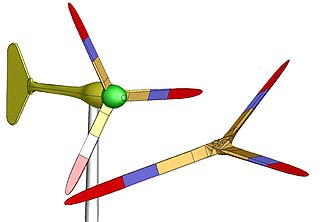
Small wind turbines, also known as micro wind turbines, generate electricity for small-scale use. These turbines are typically smaller than those found in wind farms. Small wind turbines often have passive yaw systems as opposed to active ones. They use a direct drive generator and use a tail fin to point into the wind, whereas larger turbines have geared powertrains that are actively pointed into the wind.
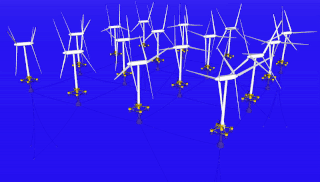
Unconventional wind turbines are those that differ significantly from the most common types in use.
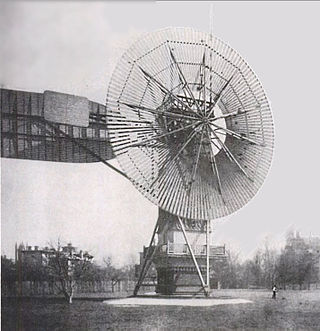
Wind power has been used as long as humans have put sails into the wind. For more than two millennia wind-powered machines have ground grain and pumped water. Wind power was widely available and not confined to the banks of fast-flowing streams, or later, requiring sources of fuel. Wind-powered pumps drained the polders of the Netherlands, and in arid regions such as the American mid-west or the Australian outback, wind pumps provided water for livestock and steam engines.
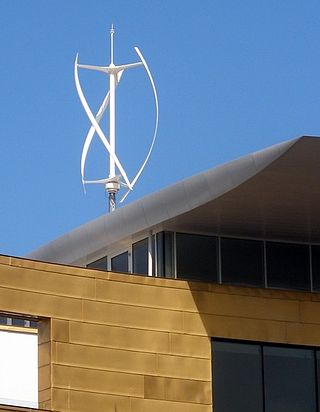
Quietrevolution is a brand of vertical-axis wind turbines owned since 2014 by VWT Power in the United Kingdom.
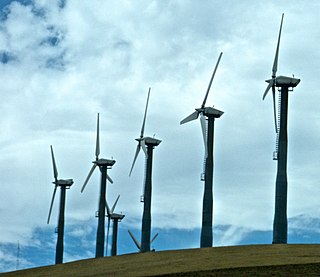
The Altamont Pass wind farm is located in the Altamont Pass of the Diablo Range in Northern California. It is one of the earliest wind farms in the United States. The first wind turbines were placed on the Altamont in the early 1980s by Fayette Manufacturing Corporation on land owned by cattle rancher Joe Jess. The wind farm is composed of 4930 relatively small wind turbines of various types, making it at one time the largest wind farm in the world in terms of capacity. Altamont Pass is still one of the largest concentration of wind turbines in the world, with a capacity of 576 megawatts (MW), producing about 125 MW on average and 1.1 terawatt-hours (TWh) yearly. They were installed after the 1970s energy crisis in response to favorable tax policies for investors.

The San Gorgonio Pass wind farm is a wind farm that stretches from the eastern slope of the San Gorgonio Pass, near Cabazon, to North Palm Springs, on the western end of the Coachella Valley, in Riverside County, California. Flanked by Mount San Gorgonio and the Transverse Ranges to the North, and Mount San Jacinto and the Peninsular Ranges to the South, the San Gorgonio Pass is a transitional zone from a Mediterranean climate west of the pass, to a Desert climate east of the pass. This makes the pass area one of the most consistently windy places in the United States.
The RES Group is a global renewable energy company which has been active in the renewable energy industry for over 30 years. Its core business is to develop, construct and operate large-scale, grid-connected renewable energy projects worldwide for commercial, industrial and utility clients. RES is active in the wind and solar energy sectors and is increasingly focused on the transition to a low-carbon economy providing transmission, energy storage and demand side management expertise.
There are a number of wind power projects in the state of Maine, totaling more than 900 megawatts (MW) in capacity. In 2020 they were responsible for 24% of in-state electricity production. In 2019, Maine had more wind capacity than the other five New England states combined, at 923 MW.
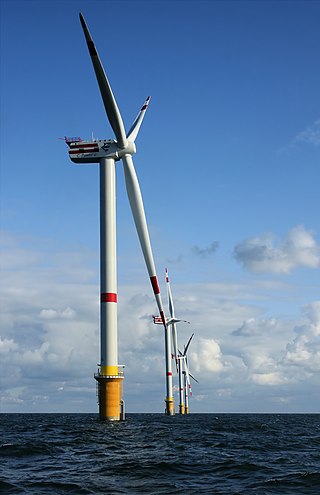
A wind turbine is a device that converts the kinetic energy of wind into electrical energy. As of 2020, hundreds of thousands of large turbines, in installations known as wind farms, were generating over 650 gigawatts of power, with 60 GW added each year. Wind turbines are an increasingly important source of intermittent renewable energy, and are used in many countries to lower energy costs and reduce reliance on fossil fuels. One study claimed that, as of 2009, wind had the "lowest relative greenhouse gas emissions, the least water consumption demands and the most favorable social impacts" compared to photovoltaic, hydro, geothermal, coal and gas energy sources.

A tidal stream generator, often referred to as a tidal energy converter (TEC), is a machine that extracts energy from moving masses of water, in particular tides, although the term is often used in reference to machines designed to extract energy from run of river or tidal estuarine sites. Certain types of these machines function very much like underwater wind turbines, and are thus often referred to as tidal turbines. They were first conceived in the 1970s during the oil crisis.

Starting in 1975, NASA managed a program for the United States Department of Energy and the United States Department of Interior to develop utility-scale wind turbines for electric power, in response to the increase in oil prices. A number of the world's largest wind turbines were developed and tested under this pioneering program. The program was an attempt to leap well beyond the then-current state of the art of wind turbine generators, and developed a number of technologies later adopted by the wind turbine industry. The development of the commercial industry however was delayed by a significant decrease in competing energy prices during the 1980s.

The great majority of wind turbines around the world belong to individuals or corporations who use them to generate electric power or to perform mechanical work. As such, wind turbines are primarily designed to be working devices. However, the large size and height above surroundings of modern industrial wind turbines, combined with their moving rotors, often makes them among the most conspicuous objects in their areas. A few localities have exploited the attention-getting nature of wind turbines by placing them on public display, either with visitor centers on their bases, or with viewing areas farther away. The wind turbines themselves are generally of conventional horizontal-axis, three-bladed design, and generate power to feed electrical grids, but they also serve the unconventional roles of technology demonstration, public relations, and education.
The following outline is provided as an overview of and topical guide to wind energy:

John Oluseun Dabiri is a Nigerian-American aeronautics engineer and the Centennial Chair Professor at the California Institute of Technology (Caltech), with appointments in the Graduate Aerospace Laboratories (GALCIT) and Mechanical Engineering. His research focuses on unsteady fluid mechanics and flow physics, with particular emphasis on topics relevant to biology, energy, and the environment. He is best known for his research of the hydrodynamics of jellyfish propulsion and the design of a vertical-axis wind farm adapted from schooling fish. He is the director of the Biological Propulsion Laboratory, which examines fluid transport with applications in aquatic locomotion, fluid dynamic energy conversion, and cardiac flows, as well as applying theoretical methods in fluid dynamics and concepts of optimal vortex formation.

A vertical-axis wind turbine (VAWT) is a type of wind turbine where the main rotor shaft is set transverse to the wind while the main components are located at the base of the turbine. This arrangement allows the generator and gearbox to be located close to the ground, facilitating service and repair. VAWTs do not need to be pointed into the wind, which removes the need for wind-sensing and orientation mechanisms. Major drawbacks for the early designs included the significant torque ripple during each revolution, and the large bending moments on the blades. Later designs addressed the torque ripple by sweeping the blades helically. Savonius vertical-axis wind turbines (VAWT) are not widespread, but their simplicity and better performance in disturbed flow-fields, compared to small horizontal-axis wind turbines (HAWT) make them a good alternative for distributed generation devices in an urban environment.